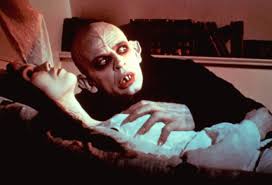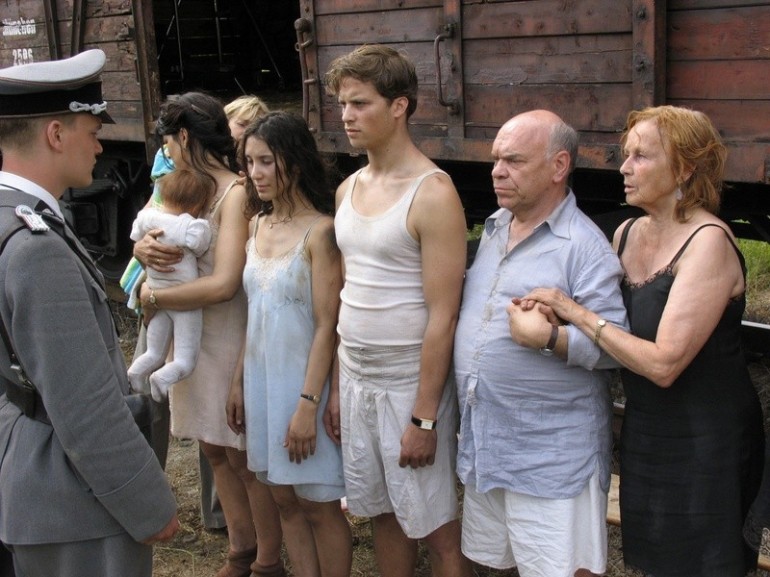
THE BUNKER. (1981) BASED ON THE BOOK BY JAMES P. O’DONNELL. STARRING ANTHONY HOPKINS, SUSAN BLAKELY, CLIFF GORMAN AND PIPER LAURIE.
REVIEW BY SANDRA HARRIS. ©
I loved this made-for-television film rendition of Hitler’s last weeks and days in the Bunker, the little underground kingdom in the nearly ruined gardens of the Reich Chancellery in Berlin where the doomed German dictator ended his life and reign of terror simultaneously.
Anthony Hopkins was brilliant as Hitler, as you might expect, because Anthony Hopkins doesn’t do anything by half-measures, but what really fascinated me here was the timing of the gradual emptying out of the bunker as the Russians came ever closer to taking Berlin and ending the Second World War, the worst war in the history of the world.
At first, when Hitler first descends in January 1945 to its murky depths, life in the Bunker is relatively civilised. Hitler takes tea at four every day with his secretaries, Gerda Christian and Traudl Junge, and Constance Manziarly (played here by Pam St. Clement, aka Pat Butcher from EastEnders!), his treasured cook, who is able to create both the bland vegetarian diet he preferred but also the home-made cakes for which he has a weakness. O-ho, so somebody likes cakes, eh…? Lol.
Hitler treats his captive female audience to the long boring monologues for which he is notorious, speeches about dogs (his dog Blondi has puppies while in the Bunker), his vegetarianism (which caused him to suffer excessive flatulence, and I’m sure the ladies would have noticed!) and the evils of smoking.
Joseph Goebbels, Hitler’s Minister for Propaganda and head toady and boot-licker, is present full-time in the bunker at this stage. So too is Martin Bormann, one of Hitler’s top men, Otto Gunsche, Hitler’s personal adjutant, Rochus Misch, the guy who works the all-important switchboard, getting messages in and out of the Bunker, and Hitler’s personal doctor, Dr. Theodor Morell, pops in and out, administering the highly unorthodox injections and (allegedly!) the cocaine eyedrops that keep the dictator going.
The situation conferences around the big table to discuss the progress of the war take place daily, and Hitler’s generals, like Guderian, Keitel, Jodl & Co. are either issued with wholly impractical orders or bawled out publicly for not having carried out the last batch. Of wholly impractical orders, lol.
Hitler in the last days of the war is moving armies around on his little maps that no longer exist, because they’ve been wiped out by the Russians, but he keeps up his outward insistence that the tide could still turn in Germany’s favour.
These situation conferences become more and more stressful for all concerned. Towards the end, when time has lost all meaning and no-one in the Bunker any longer keeps to a schedule, they could start at 1am and go on till daylight.
Hitler frequently loses his temper with his generals, whose failure to win the war for him feels like a betrayal, and his screaming fits are legendary. You can’t have a Hitler film without the little guy with the funny moustache and the queer hairstyle throwing a good old screaming fit in it.
In the last few weeks and days of April 1945, when even Hitler knows that the war is lost, things become incredibly tense and gripping to watch. Hitler’s staff beg him to leave the Bunker and flee to the relative safety of his mountain retreat in Berchtesgaden, in Bavaria. He’s adamant that he won’t leave Berlin, however.
His long-term mistress Eva Braun has joined him in the Bunker by this stage, and even her forced air of desperate oh-look-how-frightfully-gay-we-all-are has had the shine well and truly worn off of it.
She won’t leave Berlin either, however, or her Fuhrer. Whatever fate is mapped out for her Adolf, she will share it, even unto Death. She gives an expensive fur stole of hers to one of the secretaries. ‘Think of me when you wear it,’ she trills gaily. Hmmm. Even for the secretaries, who survive the war, there won’t be any opportunities to wear that fur stole for a while.
Albert Speer, Hitler’s pet architect and the Minister for Armaments, features heavily in the film. Knowing now that their dreams of rebuilding Germany together after the war are as dust in the wind, Hitler puts Speer in charge of his despicable ‘scorched earth’ policy: destroying what’s left of Germany so the Russians won’t get their hands on it. Not just bridges and military installations, but houses and shops and farms and factories as well.
The German people will have nothing left to live on when this policy has been carried out. That was probably partly what Hitler wanted all along, to take everything with him when he himself went out in a blaze of glory, like in Wagner’s Twilight of the Gods or the Götterdämmerung he’d always admired and wanted for himself and Germany.
Also, the German people had let him down, hadn’t they, by not going all out to help him win the war, so maybe they didn’t deserve to live on after he did. What a mindset. I’m fucked so all you lot are fucked as well. It seems like a pretty typical Hitlerian mentality.
Luckily for the German people, Speer in the end only pretends to Hitler that he’s been carrying out this disastrous policy. He doesn’t believe that the fate of Germany should be tied inextricably to that of one sick and twisted individual, and he’s right. He confesses to Hitler what he’s done as he’s leaving the Bunker and saying goodbye to his former Fuhrer forever, but Hitler is too far gone to give a shit by then.
Poor Hitler. His health is wrecked, his friends are deserting him right and left, his bezzy mate Himmler has actually crawled into bed with the Allies, his trademark glossy black locks are as grey as a badger’s arse now and his lovely dream of the Thousand Year Reich is in ruins.
Oh, and Eva Braun’s pregnant sister Gretl’s husband, Hermann Fegelein, has been caught trying to scarper without permission and is now paying for his crime by being left to dangle on a meathook. (Other film versions have Fegelein being shot.) What’s to live for now?
The Bunker inmates can be divided into those, like Speer, who choose to leg it while Hitler is still alive, and those who hang on till the bitter end. These include Eva Braun, Gunsche, Goebbels and his wife Magda and their six children, who are all living in the Bunker by this stage, Misch the transmissions technician, Constance Manziarly the cook (who was never seen or heard from again after the war) and the secretaries.
On the night before their joint suicide, Hitler marries Eva Braun. The next day, they say goodbye formally to their remaining acolytes, and then they retire forever to bite into cyanide capsules (previously tested on Hitler’s beloved dog, Blondi), and Hitler also shoots himself in the head for good measure. He won’t let himself be captured and hung upside-down and naked in the town square, which is what has happened to his crony Mussolini, the Italian dictator, and Mussolini’s missus.
Otto Gunsche carries the bodies outside, then sets them on fire as per Hitler’s wishes. Magda Goebbels poisons her six children with cyanide capsules, then allows her husband to shoot her dead outside in the garden before in turn shooting himself.
With the bigwigs gone, it’s every man for himself. It’s the moment when the musicians playing ‘Nearer My God To Thee’ on the Titanic pack up their instruments, wish each other well in a gentlemanly fashion and then scramble desperately for a place on a lifeboat.
The Bunker descends into chaos as Gunsche, the secretaries, Martin Bormann and assorted others pack up and try to make it through the Russian lines to the British armies, who don’t seem to be as terrifying to the Germans as their Russian counterparts.
The secretaries paint lipstick spots on their faces to give themselves the appearance of smallpox. ‘Do you want to be raped (by the Russians)?’ one says to the other. Her terrified friend promptly yanks the lippy out of her hands…!
When even the loyal and dutiful Rochus Misch eventually leaves his post and the final transmissions squawk their contents to the empty air, there’s a definite feeling in the Bunker that the fat lady has well and truly warbled her last note.
The Bunker is empty, the Fuhrer is dead, Berlin is in ruins, the war is lost and the Russians are knocking- none too politely- on the doors of the Reich Chancellery. Years and even decades in Russian prison camps await some of those fleeing from the Bunker.
What ghosts would haunt the silent corridors of the Bunker today, if it still existed, which of course it does not? Hitler is supposed to have told an underling, a young man, that his spirit would remain on duty within its walls for all eternity, keeping an eye out for those pesky Russians.
A pretty pathetic story, probably not true, but I still wouldn’t have ever wanted to be down there alone in those days after the war ended when the Bunker was dark, waterlogged and filled with the flotsam and jetsam of all those disappeared lives.
It must have been a bit like being alone on the wreck of the aforementioned Titanic. This film captures that eerie feeling perfectly, which is why I loved it. Historians are fascinated by the events that took place in the Bunker. Watch this film and you’ll get a fair idea why this is.
AUTHOR BIOGRAPHY OF SANDRA HARRIS.
Sandra Harris is a Dublin-based novelist, poet, short story writer and film and book blogger. She has studied Creative Writing and Film-Making. She has published a number of e-books on the following topics: horror film reviews, multi-genre film reviews, women’s fiction, erotic fiction, erotic horror fiction and erotic poetry. Several new books are currently in the pipeline. You can browse or buy any of Sandra’s books by following the link below straight to her Amazon Author Page:
http://www.amazon.com/-/e/B015GDE5RO
You can contact Sandra at:
https://www.facebook.com/SandraHarrisPureFilthPoetry
https://sandrafirstruleoffilmclubharris.wordpress.com
http://sexysandieblog.wordpress.com
http://serenaharker.wordpress.com
https://twitter.com/SandraAuthor









